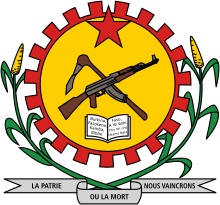Burkina Faso's coat of arms
| Burkina Faso's coat of arms | |
|---|---|

|
|
| Details | |
| Introduced | August 1997 |
| Heraldic shield | National flag |
| Sign holder | Stallions |
| Motto (motto) | Unité, Progrès, Justice ( French , "unity, progress, justice") |
| Other elements | two spears , millet ear , book |
| Previous versions |
|
The coat of arms of Burkina Faso has been in use since August 1997. It shows a shield in the middle in the style of the national flag. Two spears cross behind this shield , the upper ends of which are surrounded by a scroll with the inscription Burkina Faso , the country's name. The other ends are in turn surrounded by a scroll with Burkina Faso's motto: “Unité, Progrès, Justice” ( French , “Unity, Progress, Justice”). A millet ear can be seen to the right and left of the scroll . There is a book above the middle of the lower banner . Two silver stallions act as shield holders .
The silver stallions symbolize the honor of the Burkinabe people, the spears the determination to defend the fatherland and the open book the pursuit of knowledge. Millet ears, which were already part of the coat of arms before 1997 and go back to a motto by Thomas Sankara : “soyons burkinabè, consommons burkinabè” (analogous translation: “Citizens of Burkina Faso, let's consume Burkinabe products) stand for the goal of self-sufficiency through food ").
Historical coat of arms
With the renaming of Upper Volta to Burkina Faso as a result of the Sankarist revolution in 1984, new national symbols were created, namely a new flag and a new coat of arms. While the flag is still in use today, the “revolutionary” coat of arms was abolished with the second constitutional revision of the IV Republic in 1997 and replaced by the one used today. The coat of arms from the revolutionary era is based - for obvious reasons - graphically on the tradition of socialist republics.
The coat of arms shows a Kalashnikov crossed with a hoe over a book, framed by a stylized cogwheel and the millet ears that continue in today's coat of arms. A red star forms the top. The symbolism leaves no doubt about the ideological orientation of the revolution of 1984. It was a socialist revolution in a state that was struggling with droughts (particularly in the Sahel region at the end of the 1970s ) and in which farmers and soldiers were the most important pillars of the Represent or should represent society. At the bottom is a scroll with the inscription: "La patrie ou la mort - nous vaincrons" (French for: "Fatherland or death - we will conquer").

